Evaluation of IFD Curves and Design Storms for Sunshine Coast Council
VerifiedAdded on 2020/07/22
|11
|1893
|217
Report
AI Summary
This report provides a detailed analysis of Intensity-Frequency-Duration (IFD) curves and design storms, essential components of hydrological design procedures, particularly for urban storm drainage and civil engineering projects. It emphasizes the unreliability of single-station rainfall data and the importance of accurate IFD design rainfall data, referencing the Australian Rainfall and Runoff guidelines. The report explores the concept of design storms, including their characteristics such as temporal precipitation distribution, design return period, and spatial features, and their application in calculating peak flows for hydraulic transmission elements. Various design storm considerations, including the selection of design return periods based on economic efficiency and the level of protection, are discussed. The report also introduces common design storms like the AES and Chicago design storms, relevant to Canadian drainage practice, and highlights the institutional perspectives of clients, practitioners, hydrologists, and approval agencies. The conclusion underscores the significance of the design storm concept in drainage practice while addressing issues related to incomplete definitions and the transposition of temporal distributions. The document also includes references to key publications in the field.
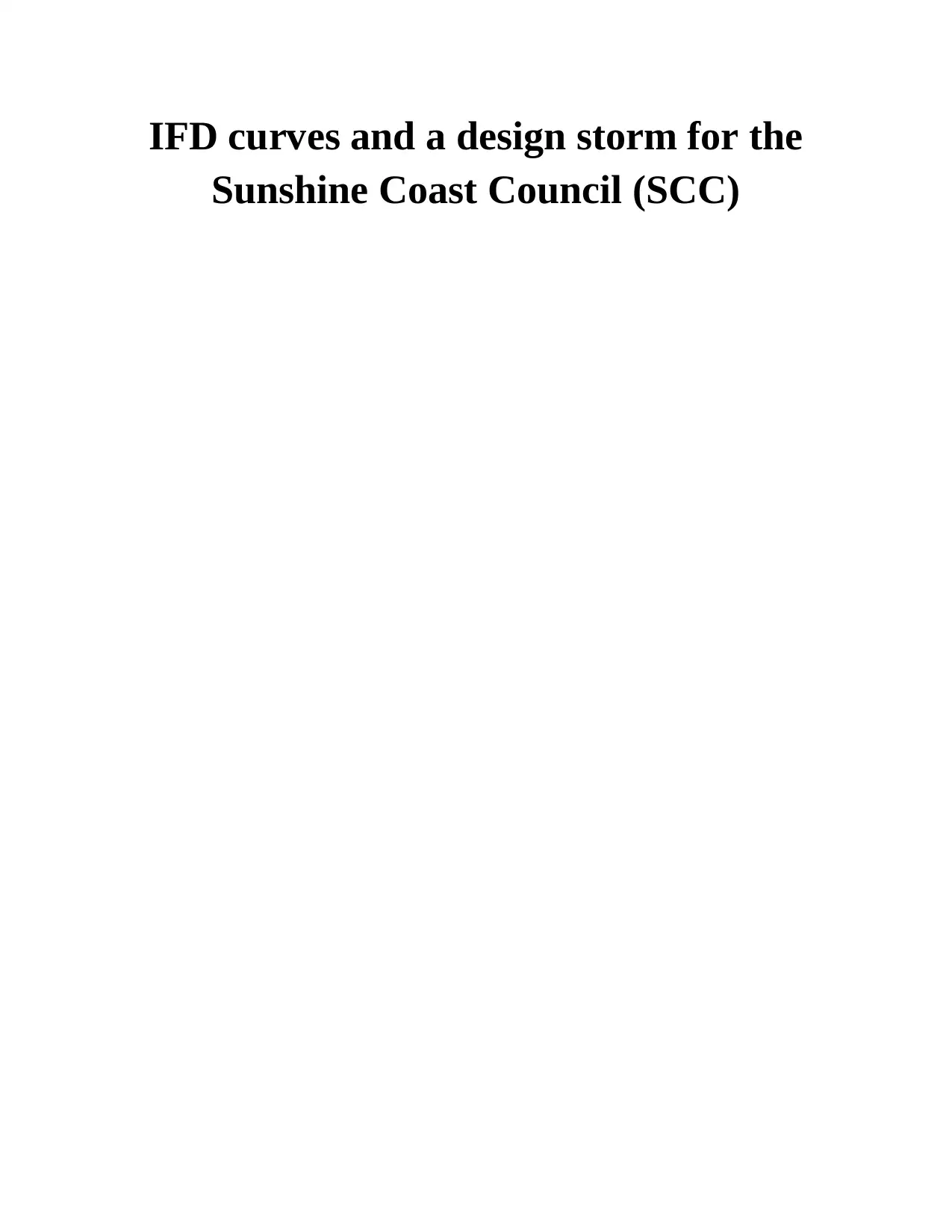
IFD curves and a design storm for the
Sunshine Coast Council (SCC)
Sunshine Coast Council (SCC)
Paraphrase This Document
Need a fresh take? Get an instant paraphrase of this document with our AI Paraphraser

Introduction
The particular frequency analysis of rain fall data is an important part of hydrological design
procedures. Evaluation of rainfall data through single stations is generally unreliable, is just not
temporally or spatially constant and should generally not be employed for design purposes. A
collection of accurate instead, consistent intensity-frequency-duration (IFD) design rainfall data
continues to be derived for the whole of Down under. This work was carried out by the Bureau
of Meteorology as part of the revision of Australian Rain fall and Runoff (Inst. Engrs Aust.,
1987). Book two, Section 1 of Quantity 1 details procedures for your construction of a set of IFD
curves for a specific area. Volume 2 contains a number of maps of intensity-frequency-duration
(IFD) design rainfall.
The particular frequency analysis of rain fall data is an important part of hydrological design
procedures. Evaluation of rainfall data through single stations is generally unreliable, is just not
temporally or spatially constant and should generally not be employed for design purposes. A
collection of accurate instead, consistent intensity-frequency-duration (IFD) design rainfall data
continues to be derived for the whole of Down under. This work was carried out by the Bureau
of Meteorology as part of the revision of Australian Rain fall and Runoff (Inst. Engrs Aust.,
1987). Book two, Section 1 of Quantity 1 details procedures for your construction of a set of IFD
curves for a specific area. Volume 2 contains a number of maps of intensity-frequency-duration
(IFD) design rainfall.
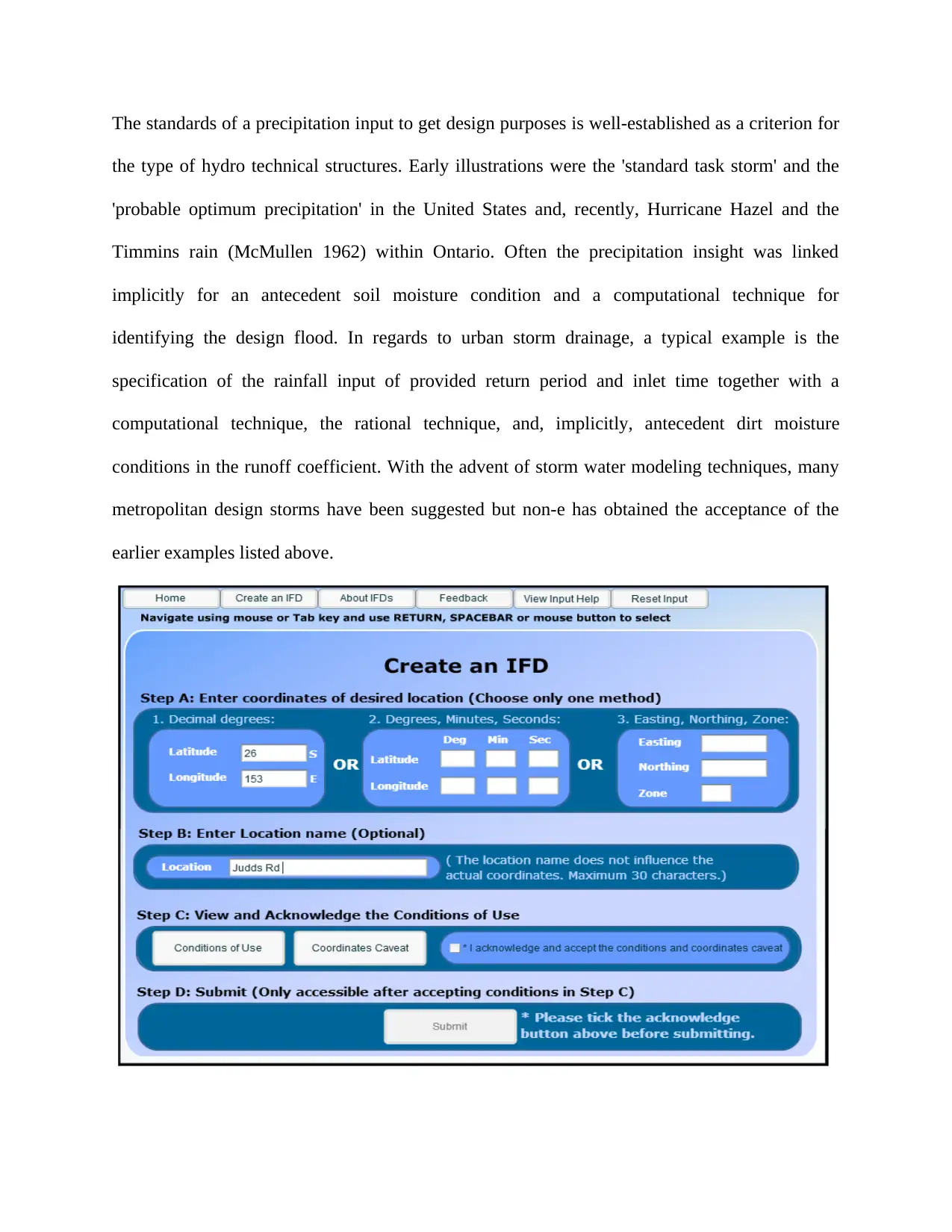
The standards of a precipitation input to get design purposes is well-established as a criterion for
the type of hydro technical structures. Early illustrations were the 'standard task storm' and the
'probable optimum precipitation' in the United States and, recently, Hurricane Hazel and the
Timmins rain (McMullen 1962) within Ontario. Often the precipitation insight was linked
implicitly for an antecedent soil moisture condition and a computational technique for
identifying the design flood. In regards to urban storm drainage, a typical example is the
specification of the rainfall input of provided return period and inlet time together with a
computational technique, the rational technique, and, implicitly, antecedent dirt moisture
conditions in the runoff coefficient. With the advent of storm water modeling techniques, many
metropolitan design storms have been suggested but non-e has obtained the acceptance of the
earlier examples listed above.
the type of hydro technical structures. Early illustrations were the 'standard task storm' and the
'probable optimum precipitation' in the United States and, recently, Hurricane Hazel and the
Timmins rain (McMullen 1962) within Ontario. Often the precipitation insight was linked
implicitly for an antecedent soil moisture condition and a computational technique for
identifying the design flood. In regards to urban storm drainage, a typical example is the
specification of the rainfall input of provided return period and inlet time together with a
computational technique, the rational technique, and, implicitly, antecedent dirt moisture
conditions in the runoff coefficient. With the advent of storm water modeling techniques, many
metropolitan design storms have been suggested but non-e has obtained the acceptance of the
earlier examples listed above.
⊘ This is a preview!⊘
Do you want full access?
Subscribe today to unlock all pages.

Trusted by 1+ million students worldwide
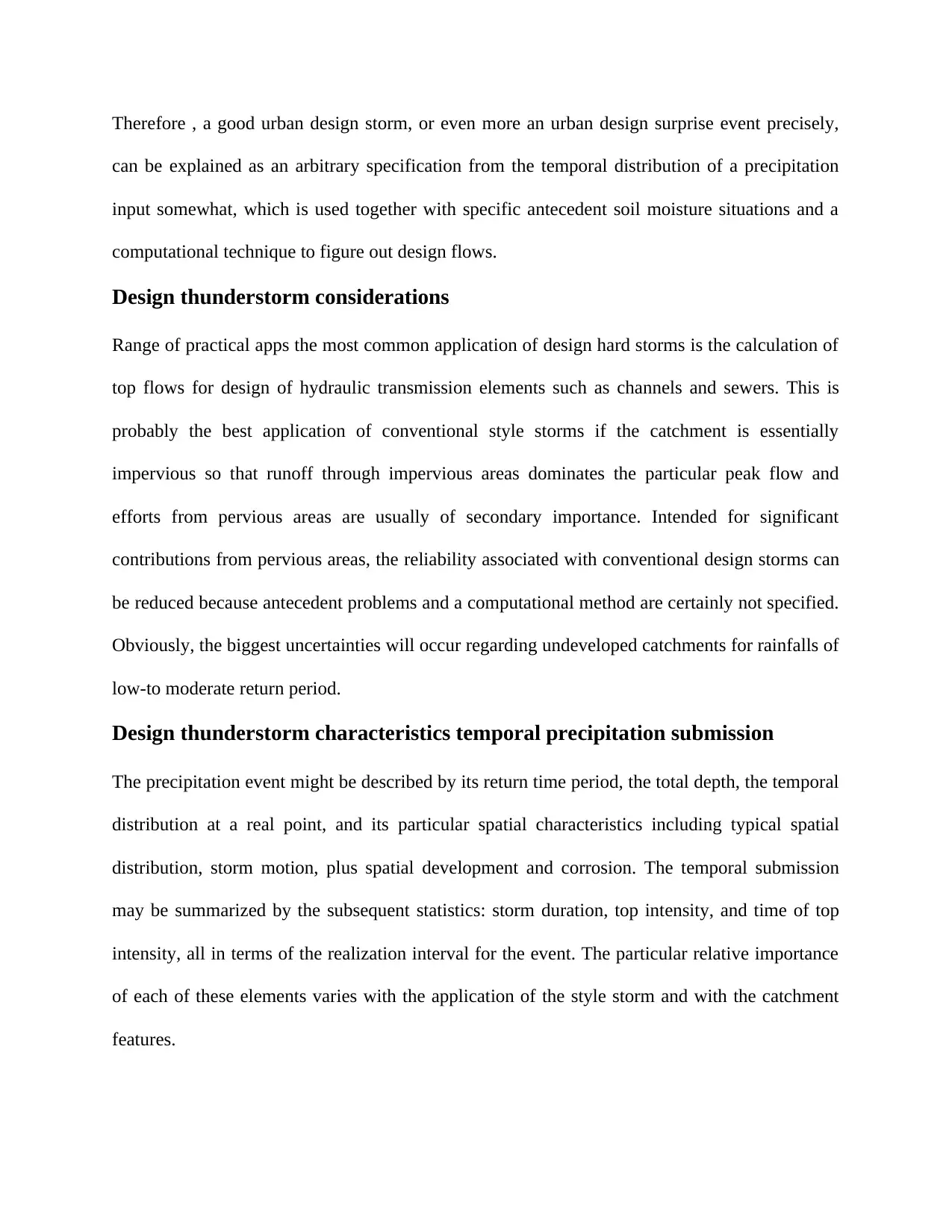
Therefore , a good urban design storm, or even more an urban design surprise event precisely,
can be explained as an arbitrary specification from the temporal distribution of a precipitation
input somewhat, which is used together with specific antecedent soil moisture situations and a
computational technique to figure out design flows.
Design thunderstorm considerations
Range of practical apps the most common application of design hard storms is the calculation of
top flows for design of hydraulic transmission elements such as channels and sewers. This is
probably the best application of conventional style storms if the catchment is essentially
impervious so that runoff through impervious areas dominates the particular peak flow and
efforts from pervious areas are usually of secondary importance. Intended for significant
contributions from pervious areas, the reliability associated with conventional design storms can
be reduced because antecedent problems and a computational method are certainly not specified.
Obviously, the biggest uncertainties will occur regarding undeveloped catchments for rainfalls of
low-to moderate return period.
Design thunderstorm characteristics temporal precipitation submission
The precipitation event might be described by its return time period, the total depth, the temporal
distribution at a real point, and its particular spatial characteristics including typical spatial
distribution, storm motion, plus spatial development and corrosion. The temporal submission
may be summarized by the subsequent statistics: storm duration, top intensity, and time of top
intensity, all in terms of the realization interval for the event. The particular relative importance
of each of these elements varies with the application of the style storm and with the catchment
features.
can be explained as an arbitrary specification from the temporal distribution of a precipitation
input somewhat, which is used together with specific antecedent soil moisture situations and a
computational technique to figure out design flows.
Design thunderstorm considerations
Range of practical apps the most common application of design hard storms is the calculation of
top flows for design of hydraulic transmission elements such as channels and sewers. This is
probably the best application of conventional style storms if the catchment is essentially
impervious so that runoff through impervious areas dominates the particular peak flow and
efforts from pervious areas are usually of secondary importance. Intended for significant
contributions from pervious areas, the reliability associated with conventional design storms can
be reduced because antecedent problems and a computational method are certainly not specified.
Obviously, the biggest uncertainties will occur regarding undeveloped catchments for rainfalls of
low-to moderate return period.
Design thunderstorm characteristics temporal precipitation submission
The precipitation event might be described by its return time period, the total depth, the temporal
distribution at a real point, and its particular spatial characteristics including typical spatial
distribution, storm motion, plus spatial development and corrosion. The temporal submission
may be summarized by the subsequent statistics: storm duration, top intensity, and time of top
intensity, all in terms of the realization interval for the event. The particular relative importance
of each of these elements varies with the application of the style storm and with the catchment
features.
Paraphrase This Document
Need a fresh take? Get an instant paraphrase of this document with our AI Paraphraser
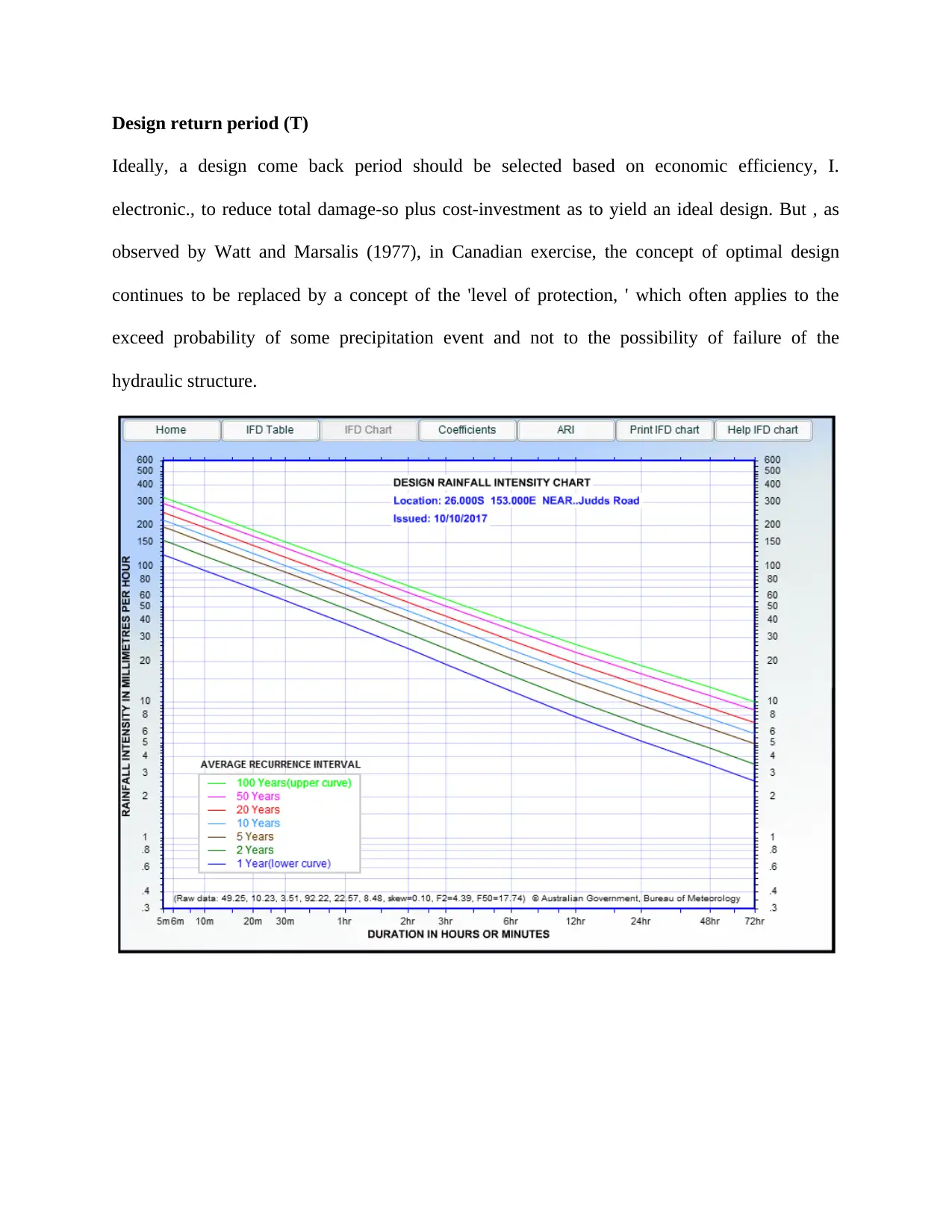
Design return period (T)
Ideally, a design come back period should be selected based on economic efficiency, I.
electronic., to reduce total damage-so plus cost-investment as to yield an ideal design. But , as
observed by Watt and Marsalis (1977), in Canadian exercise, the concept of optimal design
continues to be replaced by a concept of the 'level of protection, ' which often applies to the
exceed probability of some precipitation event and not to the possibility of failure of the
hydraulic structure.
Ideally, a design come back period should be selected based on economic efficiency, I.
electronic., to reduce total damage-so plus cost-investment as to yield an ideal design. But , as
observed by Watt and Marsalis (1977), in Canadian exercise, the concept of optimal design
continues to be replaced by a concept of the 'level of protection, ' which often applies to the
exceed probability of some precipitation event and not to the possibility of failure of the
hydraulic structure.
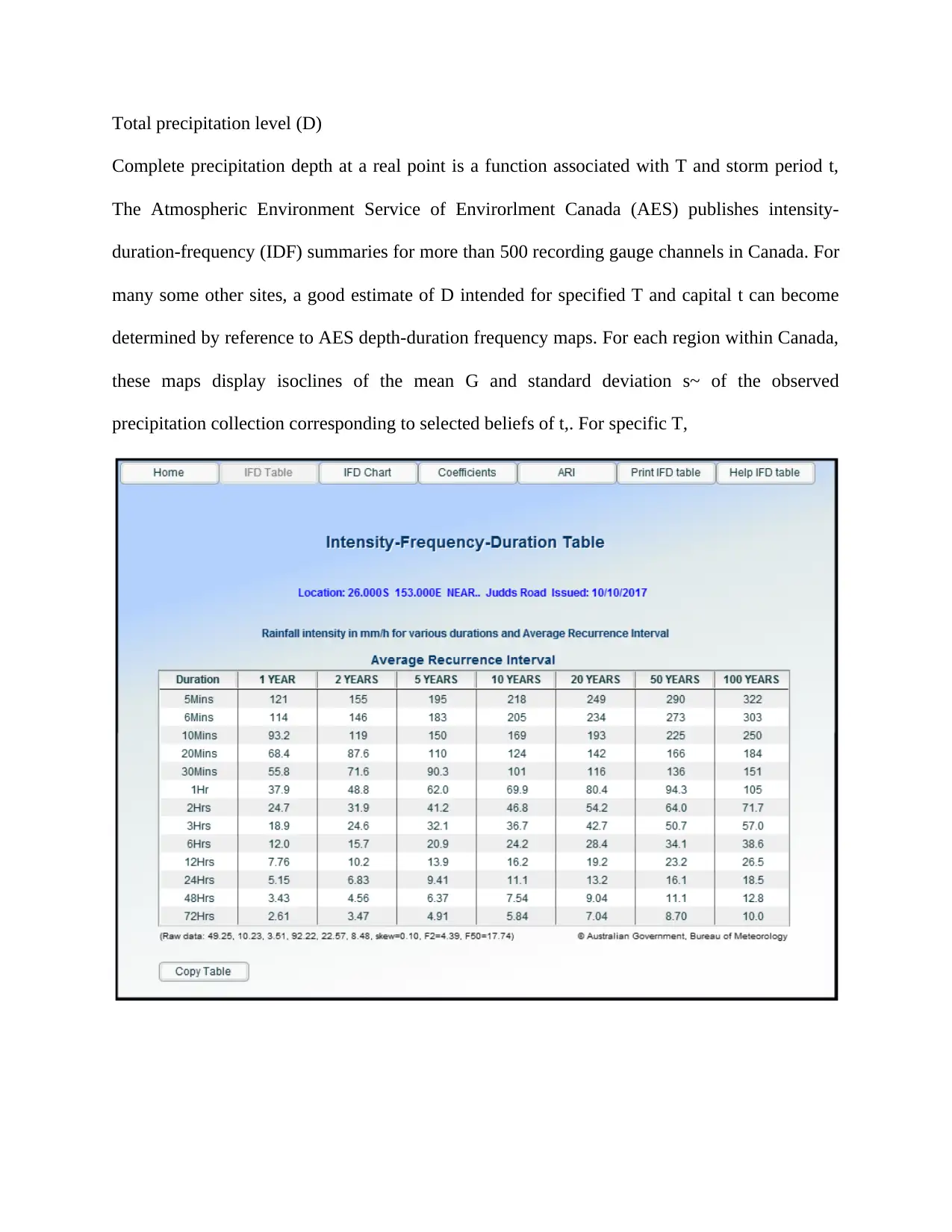
Total precipitation level (D)
Complete precipitation depth at a real point is a function associated with T and storm period t,
The Atmospheric Environment Service of Envirorlment Canada (AES) publishes intensity-
duration-frequency (IDF) summaries for more than 500 recording gauge channels in Canada. For
many some other sites, a good estimate of D intended for specified T and capital t can become
determined by reference to AES depth-duration frequency maps. For each region within Canada,
these maps display isoclines of the mean G and standard deviation s~ of the observed
precipitation collection corresponding to selected beliefs of t,. For specific T,
Complete precipitation depth at a real point is a function associated with T and storm period t,
The Atmospheric Environment Service of Envirorlment Canada (AES) publishes intensity-
duration-frequency (IDF) summaries for more than 500 recording gauge channels in Canada. For
many some other sites, a good estimate of D intended for specified T and capital t can become
determined by reference to AES depth-duration frequency maps. For each region within Canada,
these maps display isoclines of the mean G and standard deviation s~ of the observed
precipitation collection corresponding to selected beliefs of t,. For specific T,
⊘ This is a preview!⊘
Do you want full access?
Subscribe today to unlock all pages.

Trusted by 1+ million students worldwide
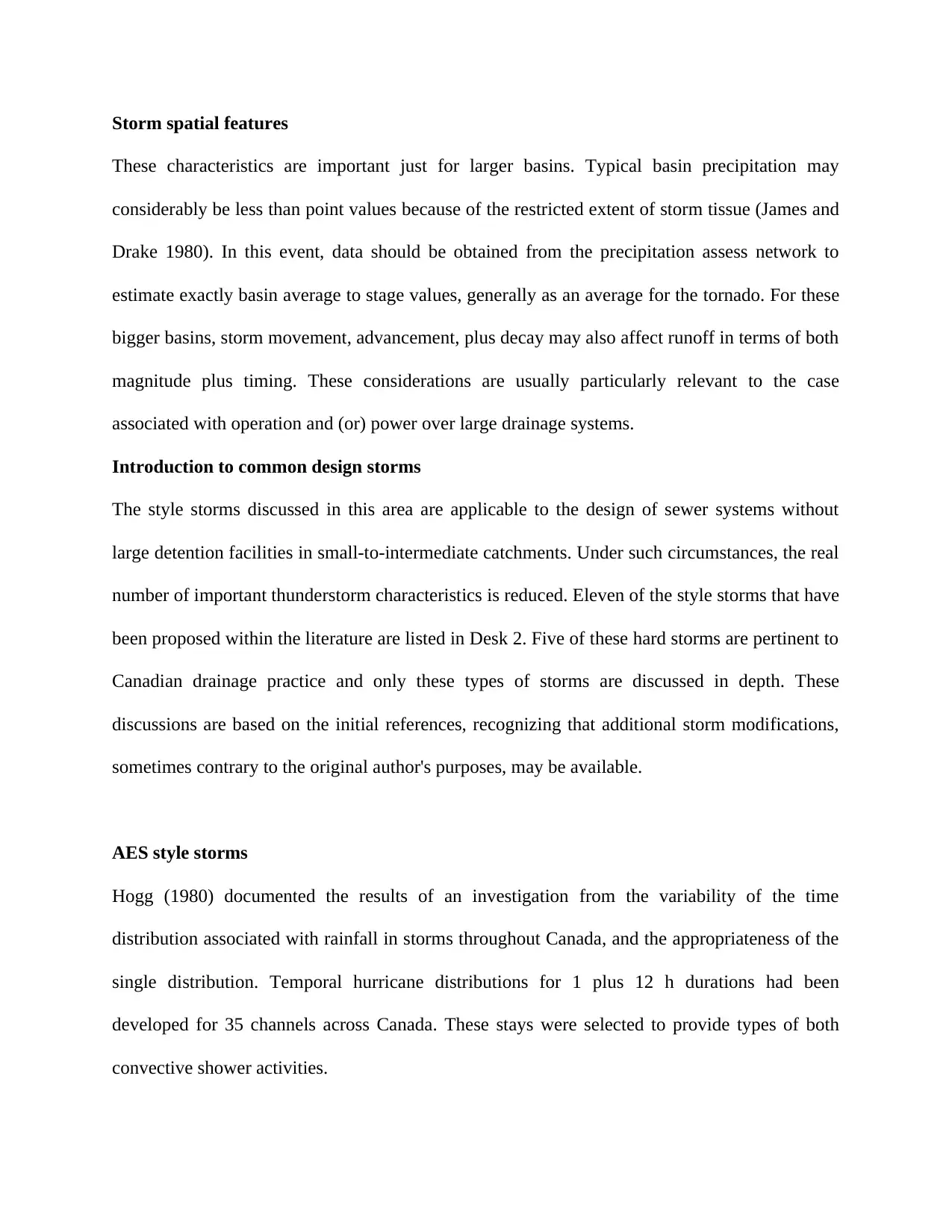
Storm spatial features
These characteristics are important just for larger basins. Typical basin precipitation may
considerably be less than point values because of the restricted extent of storm tissue (James and
Drake 1980). In this event, data should be obtained from the precipitation assess network to
estimate exactly basin average to stage values, generally as an average for the tornado. For these
bigger basins, storm movement, advancement, plus decay may also affect runoff in terms of both
magnitude plus timing. These considerations are usually particularly relevant to the case
associated with operation and (or) power over large drainage systems.
Introduction to common design storms
The style storms discussed in this area are applicable to the design of sewer systems without
large detention facilities in small-to-intermediate catchments. Under such circumstances, the real
number of important thunderstorm characteristics is reduced. Eleven of the style storms that have
been proposed within the literature are listed in Desk 2. Five of these hard storms are pertinent to
Canadian drainage practice and only these types of storms are discussed in depth. These
discussions are based on the initial references, recognizing that additional storm modifications,
sometimes contrary to the original author's purposes, may be available.
AES style storms
Hogg (1980) documented the results of an investigation from the variability of the time
distribution associated with rainfall in storms throughout Canada, and the appropriateness of the
single distribution. Temporal hurricane distributions for 1 plus 12 h durations had been
developed for 35 channels across Canada. These stays were selected to provide types of both
convective shower activities.
These characteristics are important just for larger basins. Typical basin precipitation may
considerably be less than point values because of the restricted extent of storm tissue (James and
Drake 1980). In this event, data should be obtained from the precipitation assess network to
estimate exactly basin average to stage values, generally as an average for the tornado. For these
bigger basins, storm movement, advancement, plus decay may also affect runoff in terms of both
magnitude plus timing. These considerations are usually particularly relevant to the case
associated with operation and (or) power over large drainage systems.
Introduction to common design storms
The style storms discussed in this area are applicable to the design of sewer systems without
large detention facilities in small-to-intermediate catchments. Under such circumstances, the real
number of important thunderstorm characteristics is reduced. Eleven of the style storms that have
been proposed within the literature are listed in Desk 2. Five of these hard storms are pertinent to
Canadian drainage practice and only these types of storms are discussed in depth. These
discussions are based on the initial references, recognizing that additional storm modifications,
sometimes contrary to the original author's purposes, may be available.
AES style storms
Hogg (1980) documented the results of an investigation from the variability of the time
distribution associated with rainfall in storms throughout Canada, and the appropriateness of the
single distribution. Temporal hurricane distributions for 1 plus 12 h durations had been
developed for 35 channels across Canada. These stays were selected to provide types of both
convective shower activities.
Paraphrase This Document
Need a fresh take? Get an instant paraphrase of this document with our AI Paraphraser
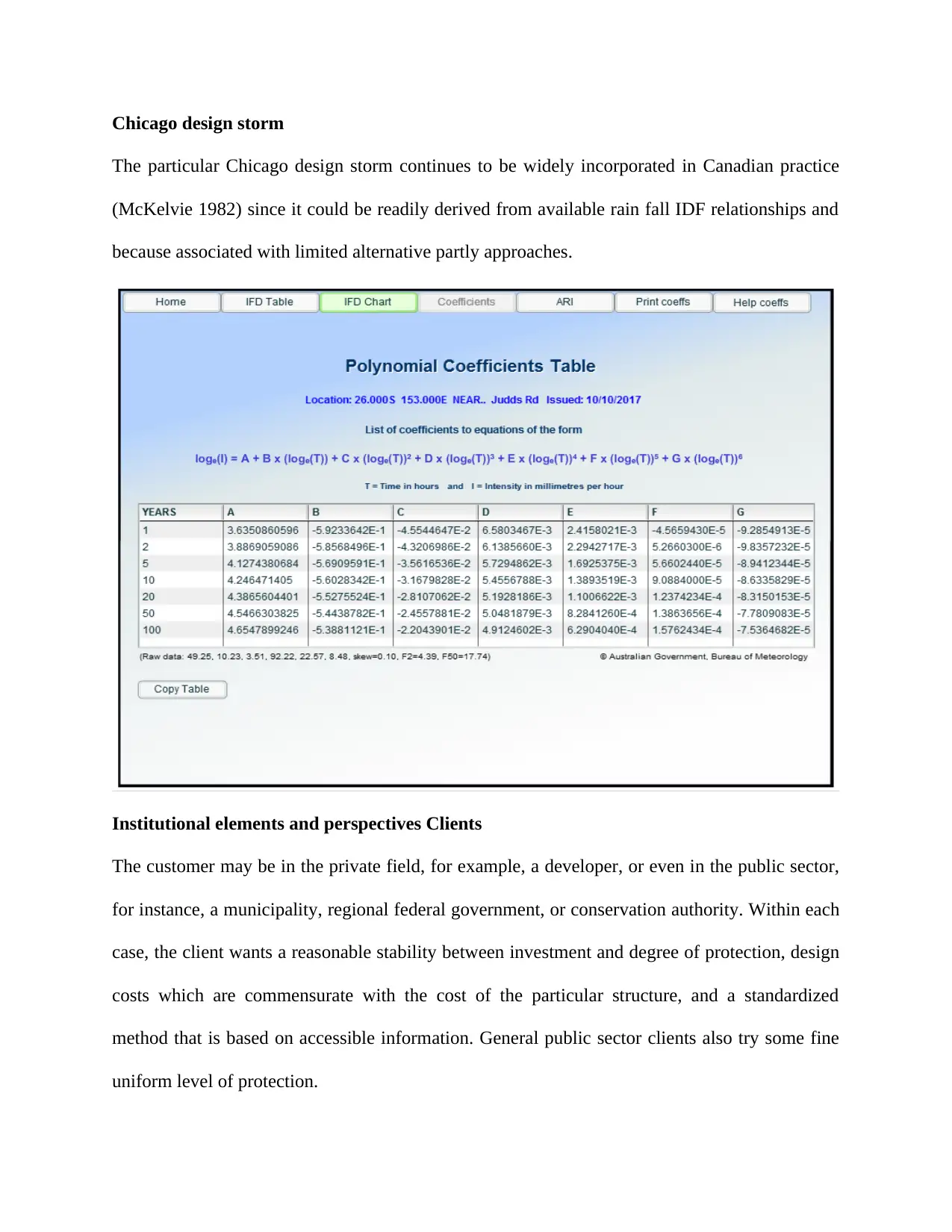
Chicago design storm
The particular Chicago design storm continues to be widely incorporated in Canadian practice
(McKelvie 1982) since it could be readily derived from available rain fall IDF relationships and
because associated with limited alternative partly approaches.
Institutional elements and perspectives Clients
The customer may be in the private field, for example, a developer, or even in the public sector,
for instance, a municipality, regional federal government, or conservation authority. Within each
case, the client wants a reasonable stability between investment and degree of protection, design
costs which are commensurate with the cost of the particular structure, and a standardized
method that is based on accessible information. General public sector clients also try some fine
uniform level of protection.
The particular Chicago design storm continues to be widely incorporated in Canadian practice
(McKelvie 1982) since it could be readily derived from available rain fall IDF relationships and
because associated with limited alternative partly approaches.
Institutional elements and perspectives Clients
The customer may be in the private field, for example, a developer, or even in the public sector,
for instance, a municipality, regional federal government, or conservation authority. Within each
case, the client wants a reasonable stability between investment and degree of protection, design
costs which are commensurate with the cost of the particular structure, and a standardized
method that is based on accessible information. General public sector clients also try some fine
uniform level of protection.
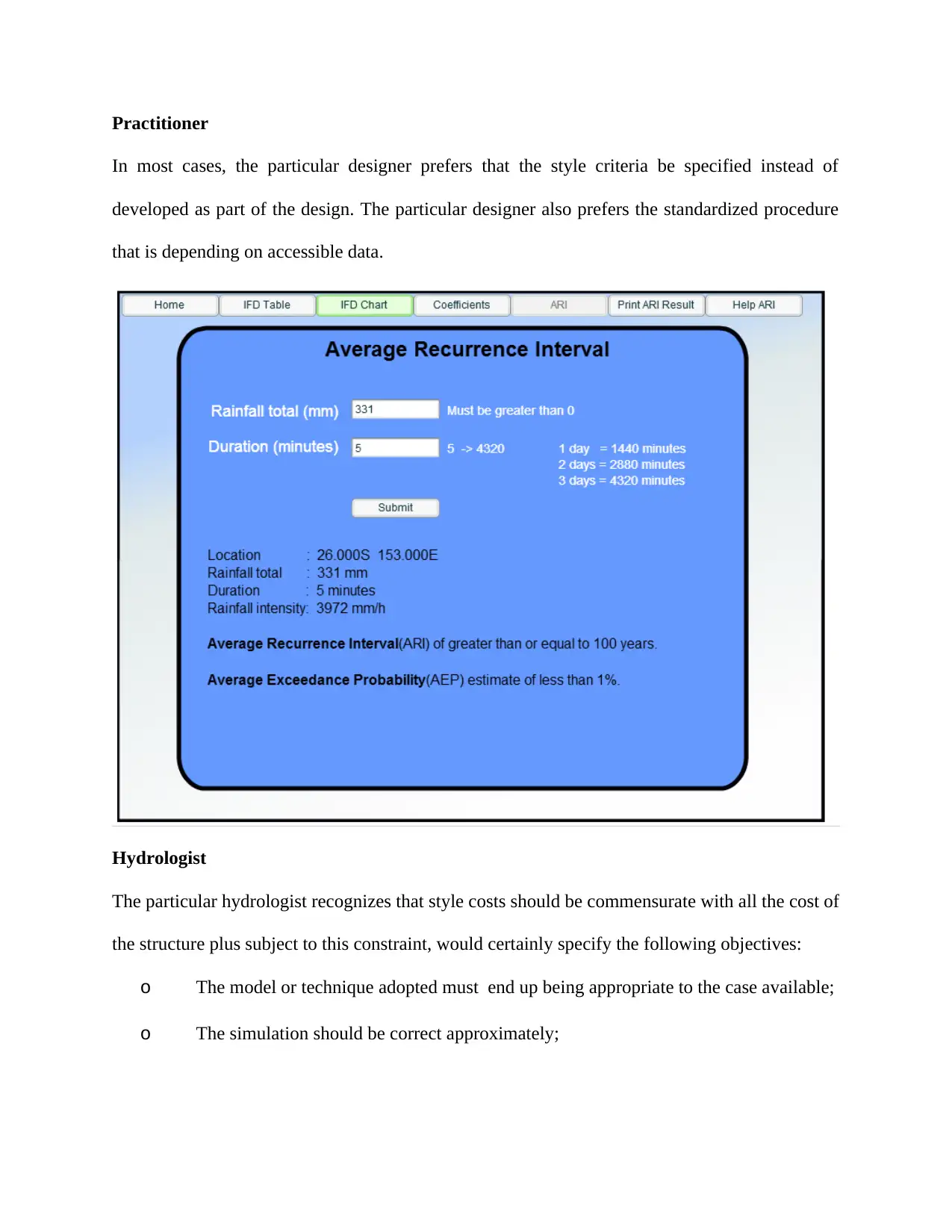
Practitioner
In most cases, the particular designer prefers that the style criteria be specified instead of
developed as part of the design. The particular designer also prefers the standardized procedure
that is depending on accessible data.
Hydrologist
The particular hydrologist recognizes that style costs should be commensurate with all the cost of
the structure plus subject to this constraint, would certainly specify the following objectives:
o The model or technique adopted must end up being appropriate to the case available;
o The simulation should be correct approximately;
In most cases, the particular designer prefers that the style criteria be specified instead of
developed as part of the design. The particular designer also prefers the standardized procedure
that is depending on accessible data.
Hydrologist
The particular hydrologist recognizes that style costs should be commensurate with all the cost of
the structure plus subject to this constraint, would certainly specify the following objectives:
o The model or technique adopted must end up being appropriate to the case available;
o The simulation should be correct approximately;
⊘ This is a preview!⊘
Do you want full access?
Subscribe today to unlock all pages.

Trusted by 1+ million students worldwide
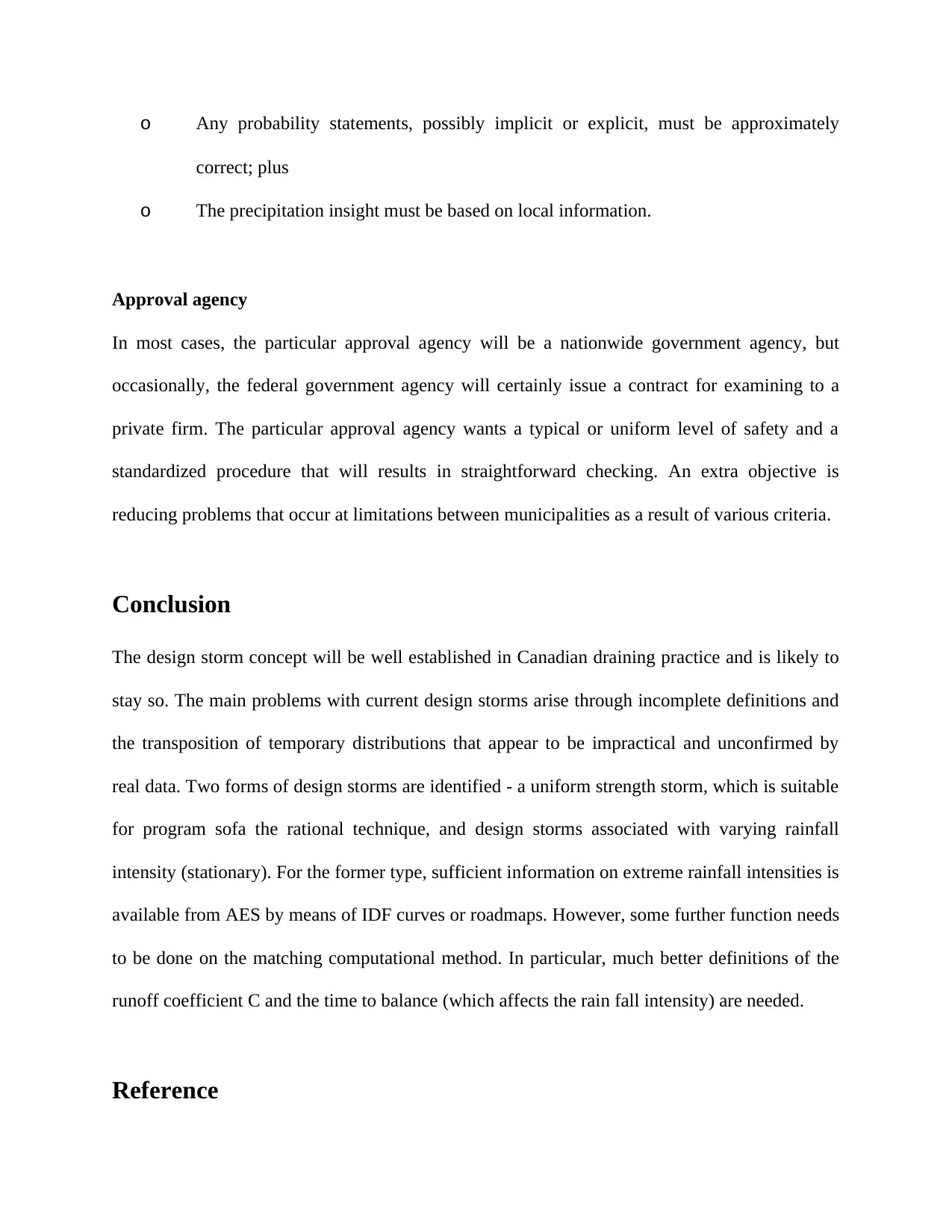
o Any probability statements, possibly implicit or explicit, must be approximately
correct; plus
o The precipitation insight must be based on local information.
Approval agency
In most cases, the particular approval agency will be a nationwide government agency, but
occasionally, the federal government agency will certainly issue a contract for examining to a
private firm. The particular approval agency wants a typical or uniform level of safety and a
standardized procedure that will results in straightforward checking. An extra objective is
reducing problems that occur at limitations between municipalities as a result of various criteria.
Conclusion
The design storm concept will be well established in Canadian draining practice and is likely to
stay so. The main problems with current design storms arise through incomplete definitions and
the transposition of temporary distributions that appear to be impractical and unconfirmed by
real data. Two forms of design storms are identified - a uniform strength storm, which is suitable
for program sofa the rational technique, and design storms associated with varying rainfall
intensity (stationary). For the former type, sufficient information on extreme rainfall intensities is
available from AES by means of IDF curves or roadmaps. However, some further function needs
to be done on the matching computational method. In particular, much better definitions of the
runoff coefficient C and the time to balance (which affects the rain fall intensity) are needed.
Reference
correct; plus
o The precipitation insight must be based on local information.
Approval agency
In most cases, the particular approval agency will be a nationwide government agency, but
occasionally, the federal government agency will certainly issue a contract for examining to a
private firm. The particular approval agency wants a typical or uniform level of safety and a
standardized procedure that will results in straightforward checking. An extra objective is
reducing problems that occur at limitations between municipalities as a result of various criteria.
Conclusion
The design storm concept will be well established in Canadian draining practice and is likely to
stay so. The main problems with current design storms arise through incomplete definitions and
the transposition of temporary distributions that appear to be impractical and unconfirmed by
real data. Two forms of design storms are identified - a uniform strength storm, which is suitable
for program sofa the rational technique, and design storms associated with varying rainfall
intensity (stationary). For the former type, sufficient information on extreme rainfall intensities is
available from AES by means of IDF curves or roadmaps. However, some further function needs
to be done on the matching computational method. In particular, much better definitions of the
runoff coefficient C and the time to balance (which affects the rain fall intensity) are needed.
Reference
Paraphrase This Document
Need a fresh take? Get an instant paraphrase of this document with our AI Paraphraser
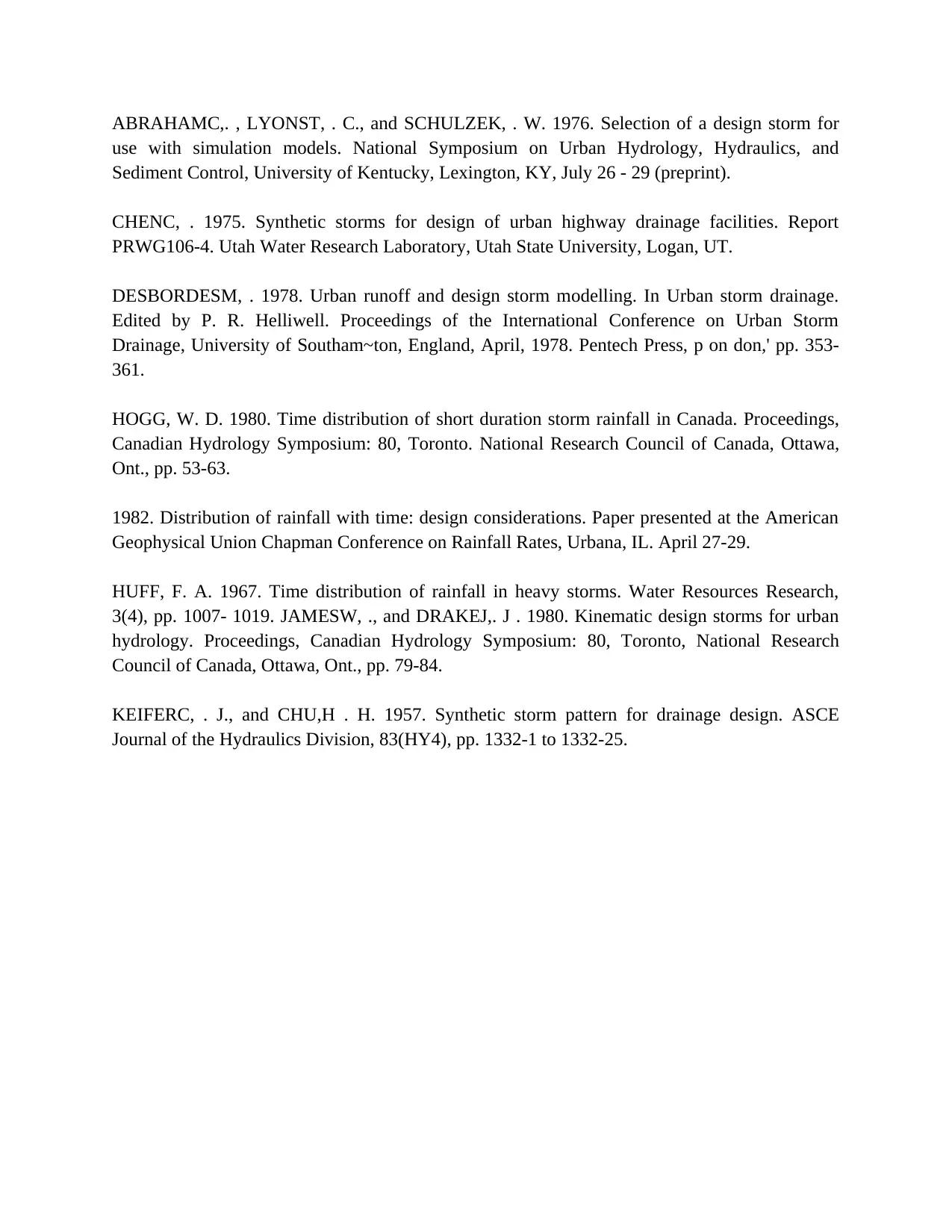
ABRAHAMC,. , LYONST, . C., and SCHULZEK, . W. 1976. Selection of a design storm for
use with simulation models. National Symposium on Urban Hydrology, Hydraulics, and
Sediment Control, University of Kentucky, Lexington, KY, July 26 - 29 (preprint).
CHENC, . 1975. Synthetic storms for design of urban highway drainage facilities. Report
PRWG106-4. Utah Water Research Laboratory, Utah State University, Logan, UT.
DESBORDESM, . 1978. Urban runoff and design storm modelling. In Urban storm drainage.
Edited by P. R. Helliwell. Proceedings of the International Conference on Urban Storm
Drainage, University of Southam~ton, England, April, 1978. Pentech Press, p on don,' pp. 353-
361.
HOGG, W. D. 1980. Time distribution of short duration storm rainfall in Canada. Proceedings,
Canadian Hydrology Symposium: 80, Toronto. National Research Council of Canada, Ottawa,
Ont., pp. 53-63.
1982. Distribution of rainfall with time: design considerations. Paper presented at the American
Geophysical Union Chapman Conference on Rainfall Rates, Urbana, IL. April 27-29.
HUFF, F. A. 1967. Time distribution of rainfall in heavy storms. Water Resources Research,
3(4), pp. 1007- 1019. JAMESW, ., and DRAKEJ,. J . 1980. Kinematic design storms for urban
hydrology. Proceedings, Canadian Hydrology Symposium: 80, Toronto, National Research
Council of Canada, Ottawa, Ont., pp. 79-84.
KEIFERC, . J., and CHU,H . H. 1957. Synthetic storm pattern for drainage design. ASCE
Journal of the Hydraulics Division, 83(HY4), pp. 1332-1 to 1332-25.
use with simulation models. National Symposium on Urban Hydrology, Hydraulics, and
Sediment Control, University of Kentucky, Lexington, KY, July 26 - 29 (preprint).
CHENC, . 1975. Synthetic storms for design of urban highway drainage facilities. Report
PRWG106-4. Utah Water Research Laboratory, Utah State University, Logan, UT.
DESBORDESM, . 1978. Urban runoff and design storm modelling. In Urban storm drainage.
Edited by P. R. Helliwell. Proceedings of the International Conference on Urban Storm
Drainage, University of Southam~ton, England, April, 1978. Pentech Press, p on don,' pp. 353-
361.
HOGG, W. D. 1980. Time distribution of short duration storm rainfall in Canada. Proceedings,
Canadian Hydrology Symposium: 80, Toronto. National Research Council of Canada, Ottawa,
Ont., pp. 53-63.
1982. Distribution of rainfall with time: design considerations. Paper presented at the American
Geophysical Union Chapman Conference on Rainfall Rates, Urbana, IL. April 27-29.
HUFF, F. A. 1967. Time distribution of rainfall in heavy storms. Water Resources Research,
3(4), pp. 1007- 1019. JAMESW, ., and DRAKEJ,. J . 1980. Kinematic design storms for urban
hydrology. Proceedings, Canadian Hydrology Symposium: 80, Toronto, National Research
Council of Canada, Ottawa, Ont., pp. 79-84.
KEIFERC, . J., and CHU,H . H. 1957. Synthetic storm pattern for drainage design. ASCE
Journal of the Hydraulics Division, 83(HY4), pp. 1332-1 to 1332-25.
1 out of 11
Your All-in-One AI-Powered Toolkit for Academic Success.
+13062052269
info@desklib.com
Available 24*7 on WhatsApp / Email
![[object Object]](/_next/static/media/star-bottom.7253800d.svg)
Unlock your academic potential
Copyright © 2020–2025 A2Z Services. All Rights Reserved. Developed and managed by ZUCOL.


